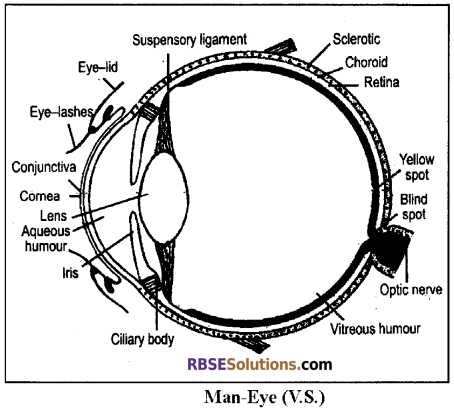Rajasthan Board RBSE Class 12 Biology Chapter 27 Man-Sensory Organs (Sense Organs)
RBSE Class 12 Biology Chapter 27 Multiple Choice Questions
Question 1.
The shape of ear ossicle, malleus is:
(a) Hammer like
(b) Stirrup like
(c) Oval
(d) None of the above
Answer:
(a) Hammer like
![]()
Question 2.
The function of cones of the eye is:
(a) Secretion, balance
(b) Vision in darkness
(c) Monocular vision
(d) Vision in the high beam of light and colour differentiation
Answer:
(d) Vision in a high beam of light and colour differentiation
Question 3.
Man in the eye defect Myopia:
(a) Unable to easily see nearer objects
(b) Unable to easily see distant objects
(c) Unable to be the monocular vision
(d) None of the above
Answer:
(b) Unable to easily see distant objects
![]()
Question 4.
The balance est lavish by the part of the internal ear is
(a) Incus
(b) Sacculus
(c) Sacculus, Utriculus, semicircular canals
(d) Organs of Corti
Answer:
(c) Sacculus, Utriculus, semicircular canals
RBSE Class 12 Biology Chapter 27 Very Short Answer Type Questions
Question 1.
Write the names of bones present in the middle ear.
Answer:
Malleus, Incus & Stapes
Question 2.
Where the tectorial membrane is found?
Answer:
Scala Media of the cochlea of the ear.
![]()
Question 3.
Write functions of rods and cones found in the eye.
Answer:
Rods function even in dim-light and are responsible for general vision.
Cones are functional from moderate to bright light and are responsible for colour vision.
Question 4.
Which structure of the ear completes the mechanism of body balance?
Answer:
Cristae & Macullae
RBSE Class 12 Biology Chapter 27 Short Answer Type Questions
Question 1.
What is the role of the eustachian tube in the ear?
Answer:
It helps to maintain air pressure in the middle ear.
Question 2.
Name the places found in the retina in the sequence where vision is the best and where nothing is seen.
Answer:
- Site of Best Vision – Yellow spot
- Site of no vision – Blindspot
![]()
Question 3.
Write the names of muscles found in the human eyes.
Answer:
- External rectus muscle
- Internal rectus muscle
- Superior rectus muscle
- Inferior rectus muscle
- Superior oblique muscle
- Inferior oblique muscle
Question 4.
What is myopia?
Answer:
Myopia:
- It is an eye disease which may occur to any person at any age.
- The person is unable to see distant objects clearly.
- It is caused either due to increased focal power of the lens (lens become more convex) or eyeball becomes larger.
- It is also called a short-sightedness.
- It can be corrected by use of biconcave lenses, which are also called as “minus lenses”.
![]()
Question 5.
What do you mean by colour blindness?
Answer:
Colourblindness:
- It is a hereditary eye disease. It was first described by Horner. It is of 2 types –
- Red-green colourblindness
- Blue colourblindness
- The red-green colourblindness is most common & it is also called a proton defect. Red-green colourblindness is caused due to the absence of red-green cones in the retina.
- The person is unable to identify red, green, yellow & orange colours. These colours appear to be green in the absence of red cones and they appear to be red in the absence of green cones.
- It is a sex-linked disease which is caused due to a recessive gene on the x-chromosome. The mother (female) acts as a carrier. The father of a colourblind daughter is always colourblind.
- In the F1 generation of carrier mother & normal father, 50% generation will be normal, 25% will be carrier & 25% will be colourblind.
- In F1 generation of carrier mother and colourblind father, 50% of daughters will be colourblind & 50% will be carrier likely, 50% of boys will be normal & 50% will be colourblind.
- In the F1 generation of normal mother & colourblind father, all males will be normal and all daughters will be a carrier.
RBSE Class 12 Biology Chapter 27 Essay Type Questions
Question 1.
Describe various eye diseases in detail.
Answer:
Common Eye Diseases:
The various eye diseases are as follows
1. Myopia:
- It is an eye disease which may occur to any person at any age.
- The person is unable to see distant objects clearly.
- It is caused either due to increased focal power of the lens (lens become more convex) or eyeball becomes larger.
- It is also called as short-sightedness. It can be corrected by use of biconcave lenses, which are also called as “minus lenses”.
2. Hypermetropia:
- It is also called farsightedness.
- The person is unable to see near objects clearly.
- It is caused either reduced focal power of the lens (lens becomes less convex) or the eyeball becomes smaller.
- It can be corrected by the uses of biconvex lenses which are also called as plus lenses.
3. Cataract:
- It is an eye disease of old age. The eye lens gradually becomes opaque, as a result, the light rays fail to enter into the eye. Cataract disease is also known as salad motia.
- Surgical removal of the lens and either implantation of the artificial lens or use of spectacles with the convex lens is a corrective measure.
4. Astigmatism:
- It is due to the abnormal shape of the cornea, in which different curvature in different regions of cornea appears.
- It can be corrected by using cylindrical lenses.
- It can be corrected by the use of cylindrical lenses.
5. Conjunctivitis:
- This eye disease is caused due to viral or bacterial infection.
- There is inflammation & irritation in the conjunctiva. The conjunctiva also becomes red.
6. Colourblindness:
Colourblindness:
- It is a hereditary eye disease. It was first described by Horner. It is of 2 types –
- Red-green colourblindness
- Blue colourblindness
- The red-green colourblindness is most common & it is also called a proton defect. Red-green colourblindness is caused due to the absence of red-green cones in the retina.
- The person is unable to identify red, green, yellow & orange colours. These colours appear to be green in the absence of red cones and they appear to be red in the absence of green cones.
- It is a sex-linked disease which is caused due to a recessive gene on the x-chromosome. The mother (female) acts as a carrier. The father of a colourblind daughter is always colourblind.
- In the F1 generation of carrier mother & normal father, 50% generation will be normal, 25% will be carrier & 25% will be colourblind.
- In F1 generation of carrier mother and colourblind father, 50% of daughters will be colourblind & 50% will be carrier likely, 50% of boys will be normal & 50% will be colourblind.
- In the F1 generation of normal mother & colourblind father, all males will be normal and all daughters will be the carrier.
![]()
Question 2.
Describe in detail the mechanism of hearing.
Answer:
Mechanism of Hearing:
- The pinna collects sound waves & transmit the waves into the external auditory meatus. These waves strike to the tympanum, as a result, the tympanum begins to vibrate.
- The air imbalance caused in the middle ear due to vibrating tympanum is balanced by the air displaced through the eustachian tube.
- The ear ossicles convey the sound vibrations to the fenestral ovals. They amplify the vibrations by 20 times.
- The pressure imbalance caused by the vibrating fenestra ovalis membrane is balanced by the membrane of fenestra rotunda.
- The vibrating membranes of the fenestra ovalis & fenestra rotunda cause the perilymph to vibrate which in turn makes the Reissner’s membrane to vibrate.
- The vibrating Reissner’s membrane causes the endolymph in the scala media to move. As a result, the tectorial membrane moves & strikes to the organ of Corti.
Hence, the sound waves reach to the organ of Corti in the form of mechanical stimuli. - The organ of Corti converts these mechanical stimuli into electromagnetic waves and transmits these waves to the cerebellum through the VIII cranial nerve.
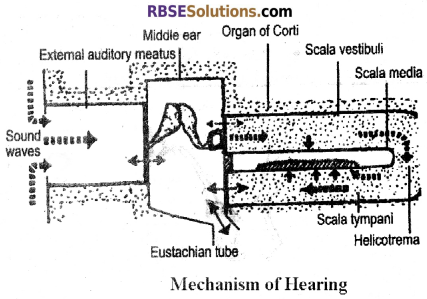
![]()
Question 3.
Describe the type of sense organs and describe them.
Answer:
Type Of Sense Organs:
There are many sense organs in the body to receive various stimuli.
Sherington classified the sense organs into three groups –
- Exteroceptors:
Example: Tangoreceptors, Photoreceptors, Rheoreceptors, Algisoreceptors, Skin receptors etc. - Interoceptors:
Example: Sense organs found in the visceral organs - Proprioceptors:
Example: Sense organs found involuntary muscles, tendons, joints, ligaments etc.
Parker classified the sense organs into 3 groups on the basis of nature of stimuli –
- Chemoreceptors
Example: Gustoreceptors, Olfactoreceptors - Mechanoreceptors
Example: Algisoreceptors, Tangoreceptors, Pressuroreceptors etc. - Radioreceptors:
Example: Thermoreceptors, Photoreceptors etc.
Both the exterior & interceptors remain interconnected by somatic & visceral sensory nerve fibres.
The receptors send the stimuli to the central nervous system.
Following sense, organs are found in human beings –
|
Photoreceptors |
Eyes | Vision |
|
Photoreceptors |
Ears |
Hearing |
| Tangoreceptors |
Skin |
Touch |
|
Gustoreceptors |
Tongue |
Taste |
|
Olfectoreceptors |
Nose |
Smell |
![]()
Question 4.
Explain the structure of the inner ear.
Answer:
Internal Ear:
- It is a semi-transparent structure which is also called the membranous labyrinth. It is situated in a bony labyrinth.
- The internal ear is surrounded by perilymph.
- It has 2 types of parts
1. Vestibule:
- It has three semicircular canals which originate from utriculus at 90°. They are called anterior, posterior & external semi-circular canals.
- The anterior & posterior semi-circular canals have a common origin which is called as crus commune.
- The distal end of the semi-circular canal forms an ampulla. The ampullae of anterior & external semicircular canals remain closely situated.
- The semi-circular canals & the ampullae are filled with a viscous fluid called endolymph.
- Each ampulla has a sensory crista. The crista is lined by a sensory epithelium provided with stereocilia & kinocilia. The kinocilium is a movable flagellum.
- The crista has an otoconium or otolith in the centre which is made up of CaCO3. The otoconia move here & there in the endolymph. The cristae are sensory to the dynamic balance.
- There is a sacculus near the utriculus which remains connected by a duct. Both the utriculus & sacculus has 1-1 macula which is sensory to static balance.
- The sacculus gives out an endolymphatic duct. It remains closed in the mammals. In fishes, it opens outside the body.
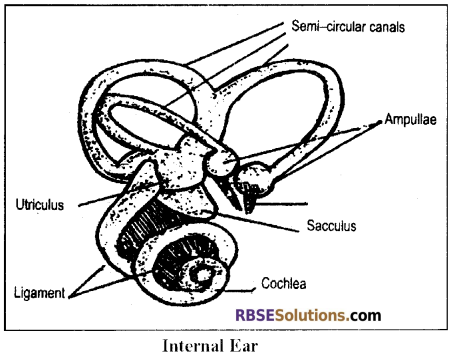
2. Cochlea:
- It is a spiral tube which originates from the sacculus. Both remain connected by a small duct called ductus reunions.
- The cochlea has 2.5 coils in rabbit and 2.75 coils in man. The coils remain linked by a soft ligament.
- Internally, the cochlea has 3 chambers viz. scala vestibule, scala media and scala tympani.
- There is a basilar membrane between scala media & scala tympani. Similarly, there is a Reissner’s membrane between scala vestibule & scala media.
- The scala vestibule & scala tympani remain united by a duct called helicotrema & they are full of perilymph fluid.
- The scala media is full of endolymph fluid.
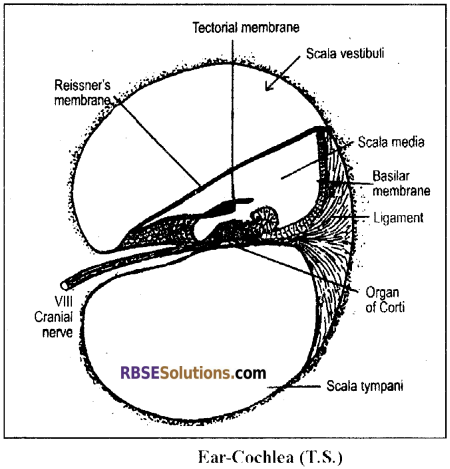
- The basilar membrane modifies to form an organ of Corti in the scala media. The organ of Corti has three types of cells viz., Deiter’s cells., Hensen’s cells & pillar cells. These cells are provided with stereocilia & their nerve fibres form VIII cranial nerve.
- There is a tectorial membrane just above the organ of Corti in the scala media which is formed by the modification of the Reissner’s membrane.
- The organ of Corti is sensory to hearing.
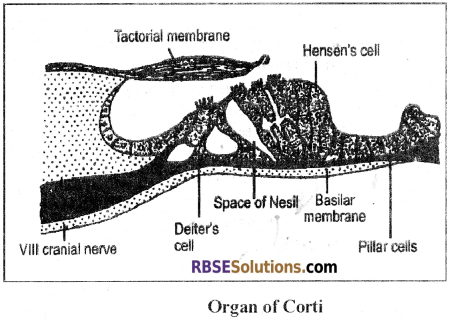
![]()
Question 5.
Describe organs of taste and olfactory organs.
Answer:
Tongue & Nose:
- The tongue gives the sense of taste and nose gives a sense of smell. Both these are chemical senses and they depend on the nature of a chemical substance.
- Sense of taste is perceived by chemoreceptors present on the tongue. The human tongue has about 10,000 taste buds present on the top and sides of the tongue.
- Odours are detected by olfactory hairs (sensory hair) that emerge from the receptors. When molecules of chemicals enter to nose with air. they stimulate sensory epithelium of nose, which send impulses to the olfactory region of the brain.
Question 6.
Describe the structure of the eye with diagrams.
Answer:
Structure of Eye Orbits:
- Each eye is attached movably with the help of 6 eye muscles in the eye orbit.
- These eye muscles are voluntary & striated.
- There are 4 rectus & 2 oblique eye muscles which are as follows –
1.Anterior or external rectus (Lateral Rectus):
- It is attached to the outer lateral side of the eyeball.
- It receives Abducens cranial nerve.
2. Posterior or internal rectus (Medial Rectus):
- It is attached to the inner (medial) side of the eyeball.
- Oculomotor cranial nerve innervates it.
3. Superior rectus:
- It is attached to the mid-dorsal side of the eyeball.
- It receives an oculomotor cranial nerve.
4. Inferior rectus:
- It is attached to the midventral side of the eyeball.
- It receives an oculomotor cranial nerve.
5. Superior oblique muscle:
- It is attached between the external rectus & superior rectus.
- It receives a trochlear cranial nerve.
6. Inferior oblique muscle:
- It is attached between the inferior rectus and external rectus.
- It receives an oculomotor cranial nerve.
Anterior rectus & posterior rectus muscles rotate the eyeball inside & outside.
Superior rectus & inferior rectus rotate the eyeballs upside & downside.
